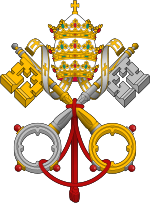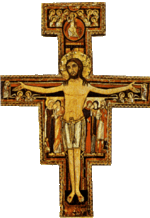Pope Cornelius
| Cornelius | |
|---|---|
 |
|
| Papacy began | March 6 or March 13, 251 |
| Papacy ended | June 253 |
| Predecessor | Fabian |
| Successor | Lucius I |
| Personal details | |
| Birth name | Cornelius |
| Born | ??? ??? |
| Died | June 253 Civitavecchia, Roman Empire |
| Papal styles of Pope Cornelius |
|
|---|---|
 |
|
| Reference style | His Holiness |
| Spoken style | Your Holiness |
| Religious style | Holy Father |
| Posthumous style | Saint |
Pope Saint Cornelius was pope from his election on 6 or 13 March 251 to his martyrdom in June 253.
Contents |
Christian persecution
Emperor Decius, who ruled from 249 to 251 AD, persecuted Christians in the Roman Empire rather sporadically and locally, but starting January in the year 250, he ordered all citizens to perform a religious sacrifice in the presence of commissioners, or else face death.[1] Many Christians refused and were martyred, including the pope, St Fabian, on January 20, while others partook in the sacrifices as to save their own lives.[2] Two schools of thought arose after the persecution. One side, lead by Novatian who was a priest in the diocese of Rome, believed that those who had stopped practicing Christianity during the persecution could not be accepted back into the church even if they repented.[3] Under this philosophy, the only way to reenter the church would be rebaptism. The opposing side, including Cornelius and Cyprian the Bishop of Carthage, did not believe in the need for rebaptism. Instead they thought that the sinners should only need to show contrition and true repentance to be welcomed back into the church.[3] In hopes that Christianity would fade away, Decius prevented the election of a new pope. However, soon after Decius was forced to leave the area to fight the invading Goths and while he was away the elections for pope were held.[2] In the 14 months without a pope, the head candidate, Moses, had died under the persecution. Novatian believed that he would be elected, however Cornelius was unwillingly elected the twenty-first pope in March 251.[3]
Papacy
Novatian was incredibly angry not only that he was not elected pope, but that someone who did not believe in rebaptism was. He thus proclaimed himself the antipope (rival) to Cornelius, driving a schism through the church. After Cornelius’s appointment to the papacy, Novatian became a larger rigorist in his philosophy, convinced that bishops could not pardon the worst of sins, and that such sins could only be reconciled at the Last Judgment.[4] Cornelius had the support of St. Cyprian, St. Dionysius, and most African and Eastern bishops while Novatian had the support of a minority of clergy and laymen in Rome who did not acknowledge Cornelius as pope.[3] Cornelius’s next action was to convene a synod of 60 bishops to restate himself as the rightful pope and the council excommunicated Novatian as well as all Novatianists. Also addressed in the synod was that Christians who stopped practicing during Emperor Decius’s persecution could receive communion once more after they showed penance.[3][4]
The verdict of the synod was sent to the Christian bishops, most notably the bishop of Antioch, a fierce Novatian supporter in order to convince him to accept Cornelius’s power. The letters that Cornelius sent to surrounding bishops provide knowledge of the size of the church during the period. Cornelius mentions that at the time, the Roman Church had, “forty six priests, seven deacons, seven sub-deacons, forty two acolytes, fifty two ostiarii, and over one thousand five hundred widows and persons in distress.”[4] His letters also inform that Cornelius had a staff of over one-hundred-fifty clergy members and the church fed over one-thousand-five-hundred people daily.[5][6] From these numbers, it has been estimated that that there were at least fifty thousand Christians in Rome during the papacy of Pope Cornelius.[3]
Death and Letters
In June of 251, Emperor Decius was killed while battling the Goths; immediately following this Trebonianus Gallus became the leader of the Roman Empire. Persecution began again in June of 252, and Pope Cornelius was exiled to Centumcellae, Italy where he died a year later in June of 253. The Liberian catalogue lists his death as being from the hardships of banishment, however later sources claim he was beheaded.[4] Cornelius is not buried in the chapel of the popes, but in a nearby catacomb, and the inscription on his tomb is in Latin, instead of Greek like predecessor Pope Fabian and successor Lucius I, and reads, “Cornelius Martyr.”[4] The letters Cornelius sent while in exile are all written in colloquial Latin of the period instead of the classical style used by those from educated backgrounds such as Cyprian, a theologian as well as bishop, and Novatian, who was also a philosopher. [4] This could suggest that Cornelius did not come from an extremely wealthy family and thus was not given a sophisticated education as a child. Also, a letter from Cornelius while in exile mentions an "exorcist" office in the church for the first time.[7] Canon law dictated that each bishopric must have an exorcist, a tradition that continued until the minor orders were suppressed by Paul VI in 1972.[8]
Referenced in History
St. Cornelius isn’t mentioned much in most texts. When he is referenced, it seems to be in conjunction with his anti-pope Novatian, who eventually founded his own church with his own bishops, predecessor St Fabian, or successor St. Lucius.[9] His papacy was short, reigning two years, three months, and ten days, and little was probably circulated at the time due to the persecution in Christian centers.[4] Over time, St. Cornelius seems to have been overlooked and passed over for other great Catholic popes whose papacies lasted longer, had more political power, and influenced other cultures. However, while Cornelius is a rather obscure religious figure, his mandates have shaped the church in historic ways.
Veneration
In the Roman Catholic Church, he is commemorated along with Cyprian in a memorial on 16 September.
In iconography, Cornelius’ attribute was the horn (in reference to the Latin origin of his name –from “cornu,” “horn”).[10] This could be either a battle horn or cow's horn.[11]
Some of his relics were taken to Germany during the Middle Ages; his head was claimed by Kornelimünster Abbey near Aachen.[10] In the Rhineland, he was also a patron saint of lovers.[10] A legend associated with Cornelius tells of a young artist who was commissioned to decorate the Corneliuskapelle in the Selikum quarter of Neuss. The daughter of a local townsman fell in love with the artist, but her father forbade the marriage, remarking that he would only consent if the pope did as well. Miraculously, the statue of Cornelius leaned forward from the altar and blessed the pair, and the two lovers were thus married.[10]
Cornelius, along with Quirinus of Neuss, Hubertus and Anthony the Great, was venerated as one of the Four Holy Marshals in the Rhineland during the late Middle Ages.[12][13][14][15]
He was also a patron saint of farmers and of cattle, and was invoked against epilepsy, cramps, afflictions associated with the nerves and ears.[10]
A legend told at Carnac states that its stones were once pagan soldiers who had been turned into stone by Cornelius, who was fleeing from them.[16][17]
The Catholic Church commemorated Cornelius by venerating him, with his Saint’s Day on the 16th of September, which he shares with his good friend St. Cyprian.[18] His Saint’s Day was originally on the 14th of September, the date on which both St. Cyprian and St. Cornelius were martyred, as proposed by St. Jerome.[4] St. Cornelius’s saintly name means battle horn, from the Latin root of his name, and he is represented in icons by a pope holding either a cow’s or battle horn or as a pope with a cow nearby. He is the patron against earache, epilepsy, fever, twitching, and also of cattle, domestic animals, earache sufferers, epileptics, and the town of Kornelimünster, Germany where his head is located.[11]
Notes
- ↑ "Decius." Encyclopædia Britannica. 2008. Encyclopædia Britannica Online School Edition. 7 Dec. 2008 <http://school.eb.com/eb/article-9029704>.
- ↑ 2.0 2.1 Saints and Feast Days. New York: Loyola P, 1991.
- ↑ 3.0 3.1 3.2 3.3 3.4 3.5 McBrien, Richard P. "Pope Cornelius, a reconciler, had a hard road." National Catholic Reporter 40.41 (Sept 24, 2004): 19(1). General OneFile. Gale. Sacred Heart Prepatory (BAISL). 5 Dec. 2008 <http://find.galegroup.com/ips/start.do?prodId=IPS>.
- ↑ 4.0 4.1 4.2 4.3 4.4 4.5 4.6 4.7
 Chapman, John (1913). "Pope Cornelius". Catholic Encyclopedia. New York: Robert Appleton Company.
Chapman, John (1913). "Pope Cornelius". Catholic Encyclopedia. New York: Robert Appleton Company. - ↑ Moody Smith, D. "Review: The Rise of Christianity: A Review." Journal of the American Academy of Religion 54 (1986): 337–42.
- ↑ Schrembs, Joseph. "The Catholic Philosophy of History." The Catholic Historical Review 20 (1934): 1–22.
- ↑ Allen, John L. Jr. (Sept 1, 2000), "A bit of exorcist history", National Catholic Reporter, http://natcath.org/NCR_Online/archives2/2000c/090100/090100h.htm
- ↑ Paul VI., MINISTERIA QUAEDAM, http://www.vatican.va/holy_father/paul_vi/motu_proprio/documents/hf_p-vi_motu-proprio_19720815_ministeria-quaedam_lt.html
- ↑ "Novatian." Encyclopædia Britannica. 2008. Encyclopædia Britannica Online School Edition. 7 Dec. 2008 <http://school.eb.com/eb/article-9056376>.
- ↑ 10.0 10.1 10.2 10.3 10.4 Cornelius - Ökumenisches Heiligenlexikon
- ↑ 11.0 11.1 "Pope Saint Cornelius." Patron Saints Index. 7 Dec. 2008.
- ↑ Quirinus von Rom (von Neuss) - Ökumenisches Heiligenlexikon
- ↑ marschaelle
- ↑ Die Kapelle
- ↑ Heimatbund St.Tönis 1952 e.V
- ↑ TheRecord.com - Travel - Marvelling at Carnac's stones
- ↑ France Holidays, Brittany
- ↑ "Saint Cornelius." Encyclopædia Britannica. 2008. Encyclopædia Britannica Online. 24 Nov. 2008 <http://www.britannica.com/EBchecked/topic/137950/Saint-Cornelius>.
Bibliography
"A bit of exorcist history." National Catholic Reporter 36.38 (Sept 1, 2000): 6. General OneFile. Gale. Sacred Heart Preparatory (BAISL). 5 Dec. 2008 <http://find.galegroup.com/ips/start.do?prodId=IPS>.
![]() Chapman, John (1913). "Pope Cornelius". Catholic Encyclopedia. New York: Robert Appleton Company.
Chapman, John (1913). "Pope Cornelius". Catholic Encyclopedia. New York: Robert Appleton Company.
"Decius." Encyclopædia Britannica. 2008. Encyclopædia Britannica Online School Edition. 7 Dec. 2008 <http://school.eb.com/eb/article-9029704>.
“Gallus." Encyclopædia Britannica. 2008. Encyclopædia Britannica Online School Edition. 7 Dec. 2008 <http://school.eb.com/eb/article-9035926>.
McBrien, Richard P. "Pope Cornelius, a reconciler, had a hard road." National Catholic Reporter 40.41 (Sept 24, 2004): 19(1). General OneFile. Gale. Sacred Heart Preparatory (BAISL). 5 Dec. 2008 <http://find.galegroup.com/ips/start.do?prodId=IPS>.
Moody Smith, D. "Review: The Rise of Christianity: A Review." Journal of the American Academy of Religion 54 (1986): 337–42.
"Novatian." Encyclopædia Britannica. 2008. Encyclopædia Britannica Online School Edition. 7 Dec. 2008 <http://school.eb.com/eb/article-9056376>.
"Pope Saint Cornelius." Patron Saints Index. 7 Dec. 2008
"Saint Cornelius." Encyclopædia Britannica. 2008. Encyclopædia Britannica Online. 24 Nov. 2008 <http://www.britannica.com/EBchecked/topic/137950/Saint-Cornelius>.
Saints and Feast Days. New York: Loyola P, 1991.
Schrembs, Joseph. "The Catholic Philosophy of History." The Catholic Historical Review 20 (1934): 1–22.
External links
 "Pope Cornelius". Catholic Encyclopedia. New York: Robert Appleton Company. 1913.
"Pope Cornelius". Catholic Encyclopedia. New York: Robert Appleton Company. 1913.- Letters of Pope Cornelius I
 Chisholm, Hugh, ed (1911). "Cornelius". Encyclopædia Britannica (Eleventh ed.). Cambridge University Press.
Chisholm, Hugh, ed (1911). "Cornelius". Encyclopædia Britannica (Eleventh ed.). Cambridge University Press.
| Catholic Church titles | ||
|---|---|---|
| Preceded by Fabian |
Bishop of Rome Pope 251–253 |
Succeeded by Lucius I |
|
|||||||||||||||||||||||||||||||||||||||||||||
|
|||||||||||||||||||||||||||||||||||||||||

